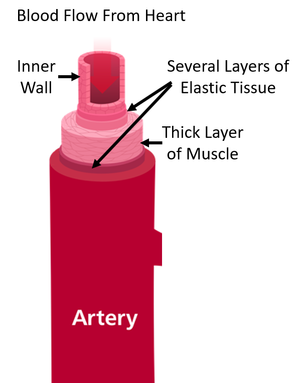Difference between revisions of "Artery"
| Line 36: | Line 36: | ||
:[https://www.amazon.co.uk/gp/product/1782945741/ref=as_li_tl?ie=UTF8&camp=1634&creative=6738&creativeASIN=1782945741&linkCode=as2&tag=nrjc-21&linkId=30da4f2178da182547b62a7329d13b57 ''Arteries, page 62, GCSE Combined Science; The Revision Guide, CGP, Edexcel ''] | :[https://www.amazon.co.uk/gp/product/1782945741/ref=as_li_tl?ie=UTF8&camp=1634&creative=6738&creativeASIN=1782945741&linkCode=as2&tag=nrjc-21&linkId=30da4f2178da182547b62a7329d13b57 ''Arteries, page 62, GCSE Combined Science; The Revision Guide, CGP, Edexcel ''] | ||
:[https://www.amazon.co.uk/gp/product/1782946748/ref=as_li_tl?ie=UTF8&camp=1634&creative=6738&creativeASIN=1782946748&linkCode=as2&tag=nrjc-21&linkId=a4f0348fc37d0ba1bb52d27f8679581f ''Arteries, page 90, GCSE Biology; The Revision Guide, CGP, Edexcel ''] | :[https://www.amazon.co.uk/gp/product/1782946748/ref=as_li_tl?ie=UTF8&camp=1634&creative=6738&creativeASIN=1782946748&linkCode=as2&tag=nrjc-21&linkId=a4f0348fc37d0ba1bb52d27f8679581f ''Arteries, page 90, GCSE Biology; The Revision Guide, CGP, Edexcel ''] | ||
| + | |||
| + | ====OCR==== | ||
| + | :[https://www.amazon.co.uk/gp/product/1782945695/ref=as_li_tl?ie=UTF8&camp=1634&creative=6738&creativeASIN=1782945695&linkCode=as2&tag=nrjc-21&linkId=ceafcc80bcad6b6754ee97a0c7ceea53 ''Arteries, pages 30, 78, Gateway GCSE Combined Science; The Revision Guide, CGP, OCR ''] | ||
| + | :[https://www.amazon.co.uk/gp/product/1782945660/ref=as_li_tl?ie=UTF8&camp=1634&creative=6738&creativeASIN=1782945660&linkCode=as2&tag=nrjc-21&linkId=83aa4500ad7759e7f401a1c5ba5df758 ''Arteries, pages 37, 104, Gateway GCSE Biology; The Revision Guide, CGP, OCR ''] | ||
| + | :[https://www.amazon.co.uk/gp/product/0198359810/ref=as_li_tl?ie=UTF8&camp=1634&creative=6738&creativeASIN=0198359810&linkCode=as2&tag=nrjc-21&linkId=d768d99f1a06f7c12fab40e5aef85a55 ''Arteries, pages 74-76, Gateway GCSE Biology, Oxford, OCR ''] | ||
Latest revision as of 17:34, 30 November 2019
Contents
Key Stage 3
Meaning
An artery is a blood vessel which carries blood away from the heart.
Key Stage 4
Meaning
An artery is a blood vessel which carries high pressure blood away from the heart.
Adaptations of Arteries
- Arteries have a thick layer of muscle to cope with the high pressure of the blood.
- Arteries have a several layers of elastic tissue which can stretch to cope with the high pressure of the blood.
| A diagram of an artery. |
About Arteries
- Most, but not all, arteries carry oxygenated blood.
References
AQA
- Arteries, page 31, GCSE Combined Science; The Revision Guide, CGP, AQA'
- Arteries, page 35, GCSE Biology; The Revision Guide, CGP, AQA'
- Arteries, page 77, GCSE Combined Science Trilogy; Biology, CGP, AQA'
- Arteries, page 83, GCSE Biology, CGP, AQA'
- Arteries, pages 51, 53, GCSE Biology, Hodder, AQA'
- Arteries, pages 51, 53, GCSE Combined Science Trilogy 1, Hodder, AQA'
- Arteries, pages 54-55, 141, GCSE Biology; Third Edition, Oxford University Press, AQA'
- Artery, pages 113, 205, GCSE Biology; Student Book, Collins, AQA'
Edexcel
- Arteries, page 114, GCSE Combined Science, Pearson Edexcel
- Arteries, page 166, GCSE Biology, Pearson, Edexcel
- Arteries, page 264, GCSE Biology, CGP, Edexcel
- Arteries, page 62, GCSE Combined Science; The Revision Guide, CGP, Edexcel
- Arteries, page 90, GCSE Biology; The Revision Guide, CGP, Edexcel
